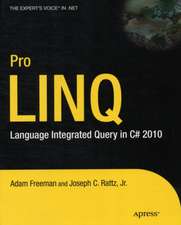Concepts of Object-Oriented Programming with Visual Basic
Autor Steven Romanen Limba Engleză Paperback – 5 dec 1996
Preț: 444.20 lei
Preț vechi: 555.25 lei
-20% Nou
Puncte Express: 666
Preț estimativ în valută:
84.100€ • 88.74$ • 70.35£
84.100€ • 88.74$ • 70.35£
Carte disponibilă
Livrare economică 14-28 martie
Preluare comenzi: 021 569.72.76
Specificații
ISBN-13: 9780387948898
ISBN-10: 0387948899
Pagini: 188
Ilustrații: XIII, 188 p. 12 illus.
Dimensiuni: 170 x 244 x 15 mm
Greutate: 0.35 kg
Ediția:1st ed. 1997. Corr. 3rd printing.
Editura: Springer
Colecția Springer
Locul publicării:New York, NY, United States
ISBN-10: 0387948899
Pagini: 188
Ilustrații: XIII, 188 p. 12 illus.
Dimensiuni: 170 x 244 x 15 mm
Greutate: 0.35 kg
Ediția:1st ed. 1997. Corr. 3rd printing.
Editura: Springer
Colecția Springer
Locul publicării:New York, NY, United States
Public țintă
Professional/practitionerCuprins
1 The Basics of Object-Oriented Programming.- Data Types.- Encapsulation.- Abstract Data Types.- Classes.- Defining a Class in Visual Basic.- Defining a Property in Visual Basic.- Defining a Method in Visual Basic.- Exposing Properties Through the Property Let/ Set/ Get Procedures.- Objects.- Explicit Object Creation.- Instance Variables and Member Variables.- The As Object Syntax.- Implicit Object Creation.- Referencing Public Variables and Procedures.- The Object/Message Model.- The Me Keyword.- Object Properties and Object Hierarchies.- Creating and Destroying Objects.- Creating Objects.- Destroying Objects.- Reference Counts.- Circular References.- The Notorious End Statement.- How to Control a Circular Reference—A Linked List Example.- Form Modules.- Properties and Methods in a Form Module.- Collection Classes.- Constructing a Collection Class.- Polymorphism and Overloading.- Overloading.- Polymorphism.- Inheritance.- 2 Handling Object Errors.- Error Detection and Error Handling.- Types of Errors.- The Error Object.- Dealing with Run-Time Errors.- Where to Handle a Run-Time Error.- Dealing with Logical Errors.- Detecting Logical Errors.- Where to Handle a Logical Error.- Handling the Error in the Calling Procedure.- Errors Occurring in Events.- An Error-Handling Example.- 3 Turing Machines — A Simple Object-Oriented Application.- What Is an Algorithm?.- What Is a Turing Machine?.- Informal Definition of a Turing Machine.- Describing a Turing Machine.- Coding a Turing Machine.- Error Handling.- The Symbol Class.- The Symbols Collection Class.- The State Class.- The States Collection Class.- The Transition Class.- The Transitions Collection Class.- The Machine Class.- The User Interface.- The Standard Module.- A Final Comment.- 4 OLE Automation Objects.- What IsOLE Automation?.- Public Really Means Public.- The Plan for This Chapter.- Communication Between OLE Automation Clients and Servers.- The Communication Problem.- Supplying Information to the Client.- What Is an Interface?.- The Vtable Interface.- Type Libraries.- OLE Interfaces.- The IUnknown Interface.- The IDispatch Interface.- Binding.- Putting It All Together.- In-Process and Out-of Process Servers.- Creating a Simple OLE Automation Server.- Creating a Simple Server.- A Small Client and the Three Forms of Binding.- Referencing the Server’s Type Library.- Registering and Unregistering a Server.- How Servers Are Started and Ended.- Reference Counts for Servers.- Servers with a Visual Interface.- Servers with Dialog Boxes.- OLE Servers That Also Function as Stand-Alone Applications.- Handling Errors.- Be Nice.- Errors from Your Server’s Servers.- Externally Creatable and Dependent Objects — The Object Hierarchy.- In-Process Issues.- Version Compatibility.- How Compatibility Can Be Affected.- How Visual Basic Handles Compatibility.- The Reference Server and Interim Builds.









![An Introduction to Java Programming and Object-Oriented Application Development [With CD-ROM]: With the Unified Process](https://i1.books-express.ro/bt/9780619217464/an-introduction-to-java-programming-and-object-oriented-application-development-with-cd-rom.jpg)



